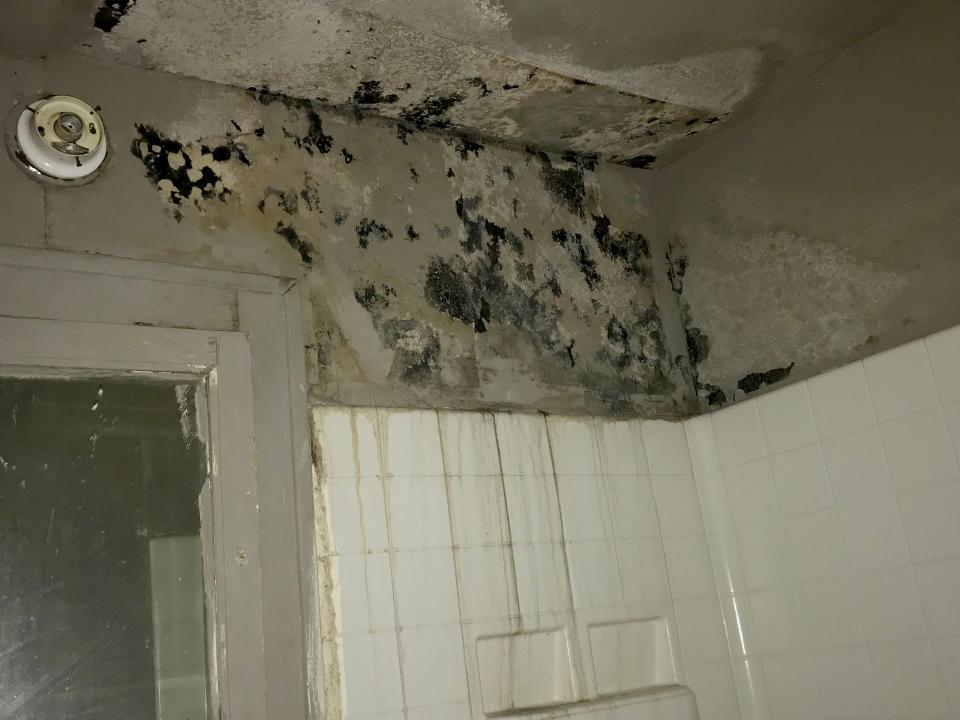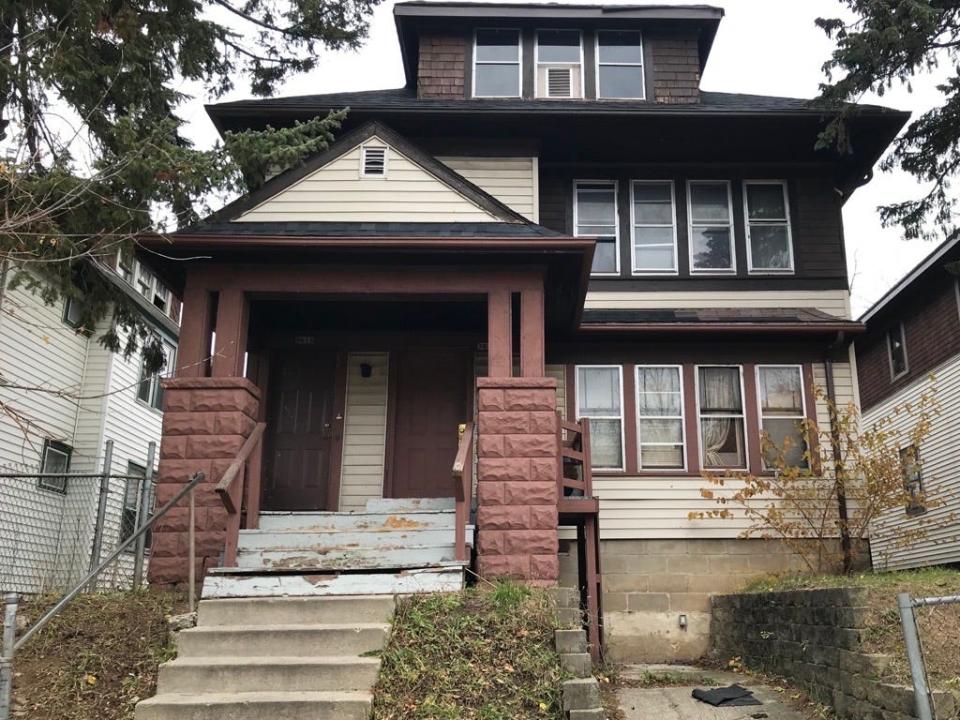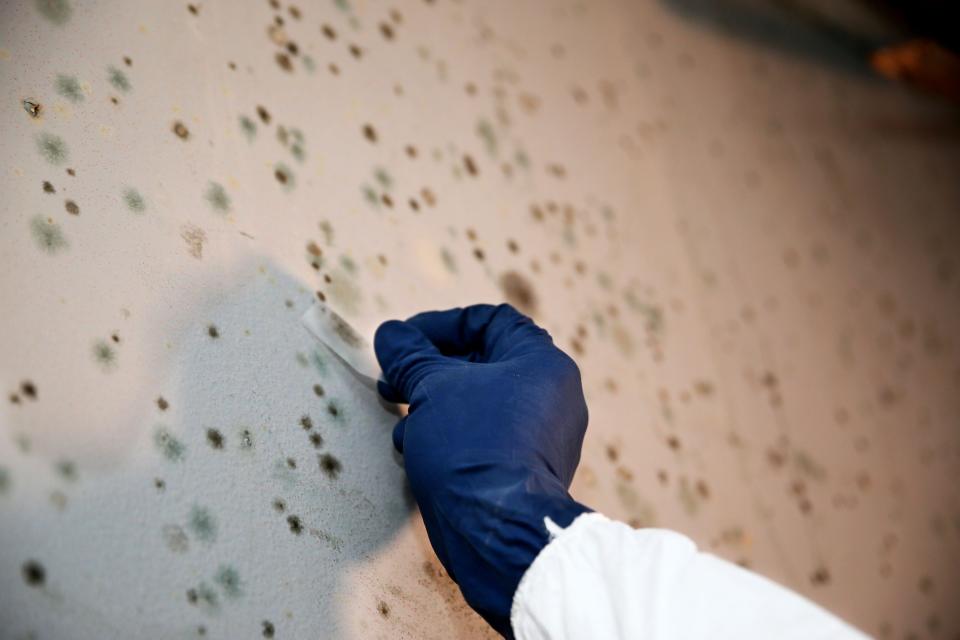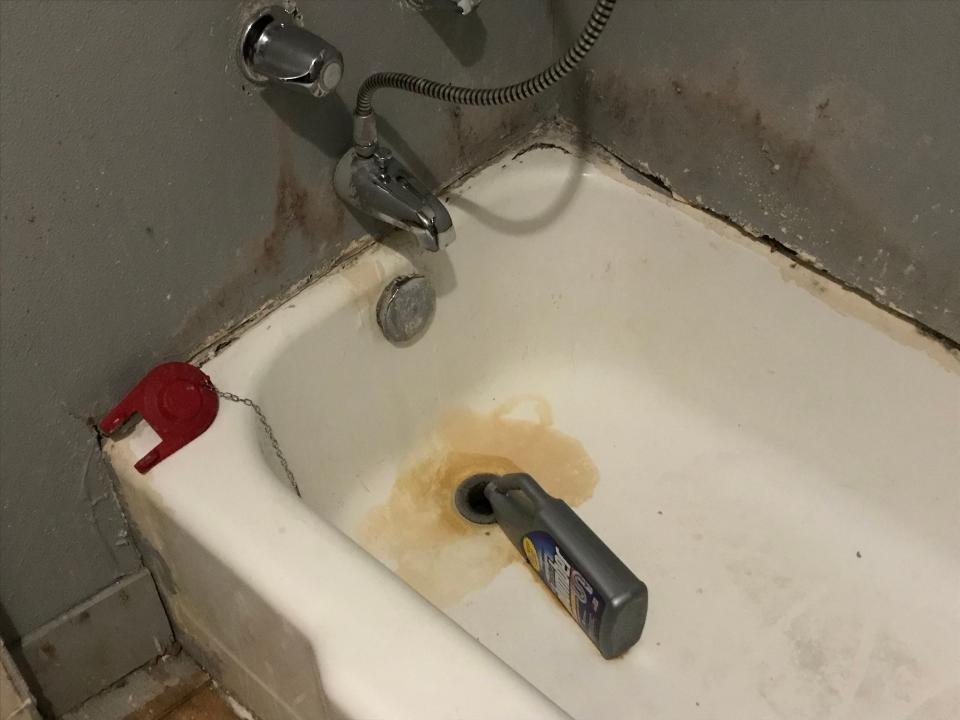'Who wants to take a hot shower in mold?' Substandard housing promotes asthma 'triggers,' and getting help can be a nightmare.
A DEVASTATING DISEASE | Q&A: SIGNS, SYMPTOMS | POSITIVE STEPS | WISCONSIN'S PLAN
Angel Harris once hoped to open a cleaning business with the motto: “Cleanliness is next to Godliness.”
But those business plans — and much of her life — have been put on hold.
Angel’s move to an older home on Milwaukee’s near north side in early winter 2020 began a chain of events that forced her and her husband, Dedric, to send their asthmatic children to live with a relative. It also triggered the Harrises’ asthma and forced Angel to return repeatedly to the hospital.
The home looked normal when they moved in.
By spring 2021, however, multiple problems had become apparent. Water dripped from the ceiling over the stove and rained down the walls whenever their upstairs neighbor showered. Lights flickered. Their bathtub clogged. Pipes leaked. And then severe mold began spreading through the home.
Although Angel reported the problems to the city, it made little difference. The smell and impact of the mold grew so strong, the Harrises started closing off rooms to avoid it.

Angel withheld rent several times, hoping it would force the landlord to make repairs. Instead, after 18 months living on Vel R. Phillips Avenue, her family was evicted in May.
Today, Angel and Dedric are homeless.
In many cases, a home — the place where families sleep, eat, study, play and relax — is the main source of asthma "triggers." Dust mites, mold, extreme heat or cold, bleach and other so-called volatile organic compounds, and infestations from cockroaches, mice and rats can all lead to severe breathing problems.
Asthmatic children who lived in neighborhoods with the most housing code violations were nearly twice as likely to return to the emergency department or hospital in 12 or fewer months, according to research done by pediatricians Robert Kahn and Andrew Beck at Cincinnati Children’s Hospital.
And the prevalence of substandard housing is likely much higher than the number of recorded housing code violations, Beck said, because many tenants are not inclined to report their landlords.
Although some children are born with asthma, research suggests exposure to these triggers may contribute to children developing asthma. One study, back in 2001, found that eliminating those triggers could reduce the number of children and adolescents diagnosed with asthma by 44% nationwide.
Unsurprisingly, low-income households are the most likely to have high concentrations of pest allergens.
Dorian James, the former coordinator for the Community Health Asthma Management Program, or CHAMP, at Children’s Wisconsin, said he has seen everything from pests and rodents to irritants such as bleach and air fresheners in the homes of asthma patients.

“I have had people show me holes in the foundation where the mice are coming in,” he said.
Erin Lee, a clinical research coordinator at the Medical College of Wisconsin and board member of Fight Asthma Milwaukee Allies, studies asthma triggers in homes.
“Mice and rats are double whammy allergen machines,” she said, pointing to how people can be allergic to the rodents’ dander and urine. Cockroaches also carry a multitude of asthma triggers for those allergic to their urine and feces. Even cockroach skin carries a protein that increases mucous production and swelling of the airways.
Lee said using pesticides can solve one problem and create another. “If you were using the sprays or the bait, you just end up with dead cockroaches between your walls, and they become a food source for the next infestation of cockroaches,” she said.
Further, nearly all homes contain varying degrees of particulate matter and what are called volatile organic compounds, both of which can trigger asthma attacks.

Particulate matter comes from anything that burns, including stoves, candles, incense, some heaters, indoor fireplaces and tobacco smoke. Volatile organic compounds include chemicals such as formaldehyde, found in carpet backings and particle board furniture; ammonia found in cleaning supplies, such as window cleaners; and terpenes found in personal care items, such as shampoos, soaps and hairsprays.
Mold, one of the most common asthma triggers, is also one of the most difficult to eliminate.
Mold causes reactions in three different ways: as an allergen, as an irritant and as a toxin. Known to cause trouble even among non-asthma sufferers, the spores from mold are transported through air and vents, and easily inhaled. Extensive mold can cost property owners thousands of dollars in repairs.
James said he recalls going into one home with mold so extreme, mushrooms had formed underneath the cabinets.
Up-to-date statistics are hard to find, which reflects asthma’s low priority in the research world. But a 2010 report estimated that exposure to dampness and mold in homes contributed to 21% of asthma cases in the United States. And a 2012 study found that infants who were exposed to three mold species most commonly present in water-damaged homes — Aspergillus ochraceus, Aspergillus unguis, and Penicillium variabile — were two to three times more likely to be diagnosed with pediatric asthma at the age of 7.
Lee educates families about asthma triggers such as these as part of her work with Fight Asthma Allies, but she acknowledged that many people are stuck in substandard housing, where they can't avoid regular exposure. Further, in neighborhoods where violence is pervasive, families keep their children indoors more, compounding the impact.
The combination of exposure to these home triggers increases asthma attacks, and makes the medications used to control asthma less effective.
James saw firsthand the difference that a change in environment can make. One mom he met had a son with severe asthma, exacerbated by roach and mice infestations and his mom’s hairstyling clients, who would smoke in the home. After killing the roaches, getting a cat to help control the mice and reducing the amount of smoke he was exposed to, her son’s asthma greatly improved.
“If we can look at the triggers in the environment and eliminate them, we can improve asthma control without having to increase medication,” he said.
But taking on unhealthy home environments can be expensive, time-consuming and for renters, complicated.
‘That’s all we smell’
Angel, 39, started renting from Will Sherard, a Milwaukee landlord, on the recommendation of a friend in December 2020.
She and her husband immediately had to deal with the furnace failing. She said it took weeks for Sherard to have the furnace repaired, and he did so only after she filed a complaint with Milwaukee’s Department of Neighborhood Services, the agency in charge of enforcing building maintenance codes.
Then mold started to appear in her daughter’s room.
When the home developed mysterious water leaks, more mold growth and flickering lights, she sent her children — Beauty, 10; Angelle, 13; Karisa, 15; Kelize, 16 and Kelben, 17 — to live with a cousin.

“They have asthma real bad,” Angel said. “My kids, they can't live in this stuff. And I told (the landlord) that they had to come and fix this in order for my kids to come back home.”
As summer turned to fall, the home — and the couple’s health — continued to decline.
“I (was) wheezing at night,” she said.
Angel found herself relying on her rescue inhaler more than ever and using a nebulizer to take her asthma mediation three times per day.
With colder temperatures sweeping in, Angel and her husband, who has bronchitis in addition to asthma, turned on the heat. That, they said, made the mold problem worse.
One night, Dedric woke up and sneezed more than a dozen times. “I (was) thinking, ‘What’s wrong?’” he recalled. They realized the mold had spread, and suspected mold spores were coming through the vents.

“That’s what we’re getting sick off of, because when we turn our heat on, that’s all we smell,” Angel said.
When the home’s main bathtub clogged, the couple started using the bathroom attached to their master bedroom. But water leaking from the upstairs apartment shorted electricity in that room. Mold in the bathroom and walk-in shower began creeping down the walls and toward the bedroom, which they soon abandoned.
“Who wants to take a hot shower in mold?” Dedric said.
Angel found herself going back and forth to the hospital.
“All of that stuff, it's messing with us,” Angel said, pointing to black and gray patches on the walls. “My doctor put me on that breathing machine and two asthma pumps because of this house.”
Kelly Jackson, a certified mold inspector and remediation specialist, said he hears about symptoms similar to the Harrises all the time.
“If a resident says, ‘I have a runny nose, my eyes are itchy, I’m not sleeping right, I’m having headaches,’ that gives me an idea of what’s going on in that home,” he said.
Jackson started a water damage restoration business, AJ Development Group, 11 years ago.
He said water leaks in poorly ventilated areas commonly lead to mold developing. When a busted pipe causes water to leak inside of walls, for example, it sits, building up bacteria and fungi. Eventually, mold spores grow and attach to porous surfaces such as drywall or wood, and grow through the wall.
In cases where mold has grown through the walls, remediation usually means tearing the walls down to the studs and rebuilding. Even though his assessments are free, Jackson said repairs can cost anywhere from $300 to $13,000, depending on the severity.
“It boils down to cost, and a lot of times with renters, the landlord is trying to ensure their profit,” Jackson said.
Tim Ballering, a board member of the Apartment Association of Southeastern Wisconsin, said most owners “strive to maintain their properties.”
“There’s going to be a few outliers,” he admitted. “In every business, there are people who don’t do what they should do.”
Renters at increased risk
The majority of asthma-triggering homes are found among renters.
A 2017 study on the role of housing and asthma suggested households with poor housing quality had 50% higher odds of visiting the emergency department for asthma attacks. Those households were overwhelmingly renters; home ownership reduced the odds of an emergency department visit by 40%.
But with the nation in the grip of an affordable housing crisis, there are more renters than ever, and many are “rent-burdened,” meaning they spend more than 30% of their income on rent.
More than half of Milwaukee County residents were renters in 2016, with the impact of being rent-burdened falling on Black households at twice the rate of white households, according to a Wisconsin Policy Forum report.
Kenneth Mendez, the president and CEO of the Asthma and Allergy Foundation of America, said today’s racial and income disparities in housing are the result of historically racist practices.
Racially restrictive covenants, redlining, exclusion from loans and targeting for subprime mortgages are all sources of today’s racial disparities in housing quality.
Angel, who lived in a neighborhood that is 80% Black, repeatedly contacted her landlord about the property’s problems. She filed additional complaints with the Department of Neighborhood Services.
In a July 15, 2021, complaint, she reported the roof was leaking over the stove, and water from the tenant above them was leaking into their unit, causing electrical problems. A July 26, 2021, complaint noted a pipe in the basement had burst, flooding it.
According to notes from DNS inspectors, the property’s rental management agency claimed repairs had been made that same day, July 26. But four days later, Angel called to inform the city the problems had not been fixed.
The entire time, she kept trying to reach her landlord.
“I even said to them, ‘I wish you guys would come and fix the house. I’m inhaling mold, and I’m getting sick,’” she recalled. “And that was August the 18th.”
The next day, she filed another complaint: “Water won't turn off in the bathroom, running down to the basement, mold has formed,” it read. “When the neighbor showers, it runs through her bathroom and a bedroom.”
Although the property manager finally sent out a repairman, he only fixed a nozzle in the bathroom and did nothing to address the mold in the home, Angel said. She was charged $89 to remove a hair tie from a bath drain.
Furious, Angel wrote to the rental management company. “So, I’m get(ting) charged for things that was broke (when) I moved into this house,” she wrote. “When are y’all going (to) come and remove the black mold from this house, so I can move back into my room, not living in the living room, and my kids can come home?”
By then, Angel had stopped paying rent again.
Some tenants hesitate to file complaints against their landlord, much less withhold rent. They fear retaliation, or worry their home could be marked as uninhabitable, leaving them homeless. Some opt to break the lease and move, or just live with the conditions.
Beck said tenants who do submit complaints “have to trust that by complaining, something good may come of that.”
Angel said filing complaints only seemed to make things worse.
'Why should I pay?'
Ultimately, Angel sent the city at least four complaints regarding conditions in the home.
Two complaints made in July were marked closed because the inspector reported that the “tenants were very aggressive” and asked the inspector to leave. A third complaint submitted in August was found not to be an emergency violation. The final complaint, in September, carried over to November, and to a new landlord.
The city and the inspectors’ inaction on mold was a constant source of frustration to the Harrises, according to the notes of a September visit by DNS. “(Tenants) complained about mold," the inspector noted. "Informed that I cannot write an order for mold but only the factors causing the mold — tenants’ mad and stated that inspector could not do anything for them.”

What the Harrises didn’t know is code enforcement agencies across the country are often leery of issuing work orders for mold violations that would force landlords to undergo costly remediation. In fact, many building codes, such as the one Milwaukee’s city department uses, do not have a direct reference to mold.
A DNS spokesperson confirmed the agency does not test for mold, accept mold complaints or regulate mold, and can only look for the source of moisture. Therefore, landlords are not required under the building codes to remediate existing mold.
In March, Sherard sold his property to Eyal Gur Investments LLC, an asset management company with ties to a Jerusalem-based marketing firm. Eyal Gur hired Citywide Rentals to manage the property locally.
The Journal Sentinel reached out to “Eyal Gur” for comment and did not hear back.
The Harrises said they paid up after the building was sold to the new owners, but stopped again in June. Records from the management company indicate at one point, they owed nearly $5,000 in rent and late fees since June 2021.
“I feel bad for not paying, but why should I pay?” Angel said. “I got tired of my house looking like a trap house. It's not fair that my kids can’t live here, and we can’t live in our room.”
A Journal Sentinel reporter observed water running down into the basement, leaks over the stove and severe mold during a mid-November visit after DNS stated the home had no violations.
In November 2021, Citywide Rentals told the Journal Sentinel they were unaware problems had persisted and sent maintenance workers. When contacted again in July 2022, a spokesperson for the company said in December, maintenance removed the added more drywall and painted the bathroom and bedroom.
However, Angel said the home still had problems in May, just a few months ago.
As of July 5, 2022, Citywide Rentals no longer managed the property.
The city does have a rent withholding program, but it is often underutilized, said Rafael Ramos, director of legal action of Wisconsin’s Eviction Defense Project. Ramos said many clients who use the project’s services don’t even know the rent withholding program exists.
Because DNS cannot force landlords to remove mold, the withholding program has a sizable loophole.
DNS currently has 23 residential code enforcement and 9 special enforcement inspectors who conduct nearly 75,000 residential inspections on an annual basis. The 2022 budget for residential and special enforcement inspectors is roughly $3.5 million.
Based on his research, Beck said building maintenance enforcement agencies like DNS tend to be “overstretched, underfunded, under resourced, underpaid and working long hours.”
But they are a crucial part of helping sustain safe and healthy housing, which in turn, reduces health care uses and costs associated with chronic diseases such as asthma.
Housing advocates say there is room for improvement. Code enforcement agencies can force landlords to remediate clear instances of mold instead of just addressing the source of it. And many want the state Legislature to support a more aggressive housing inspection system.
There are different models of housing agencies, with some merely requiring landlords to pay for a private inspection and document it, while others allow city officials to put residential properties on a schedule that rotates ever year.
Housing advocates in Milwaukee, such as the Community Advocates Public Policy Institute, say this system takes the pressure and fear off tenants, and it encourages landlords to keep their properties in good condition, never knowing when the next inspection could come.
Jonathan Wilson, the deputy director of the National Center for Health Housing, said it’s no different from restaurant inspections.
“Just as when we go to a restaurant, we don’t expect to get food poisoning from the restaurant, and we have people who inspect restaurants,” he said. “If you’re getting into the restaurant business, you should expect to have certain responsibilities. If you’re providing housing to somebody and they’re paying for that, you should give them heating and a place that’s not going to make their kids sick.”

Angel said that’s all she wanted.
But in August 2021, Eyal Gur filed an eviction against her for nonpayment of rent.
Angel enlisted a public defender and spent months trying to negotiate a payment plan, but the eviction was granted in April of this year.
“I’m losing it all because they wouldn’t fix some things and work out a payment plan. It’s not fair,” she said.
An eviction on her record makes it even harder to secure safe and stable housing.
“I wish I’d never stop(ped) paying them,” Angel said, tearing up.
For now, she and her husband are couchsurfing and her children continue to live with relatives.
They are on a list to receive public housing, but Angel’s hope is that she can own her own home one day.
“I can’t wait until we can all get together as a family, all under one roof,” she said.

This article originally appeared on Milwaukee Journal Sentinel: Milwaukee rentals can be a breeding ground for asthma triggers

